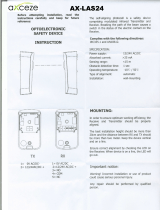
Safety Instructions
WARNING! Read these notes before attempting to operate the
RapidDome Dome
Refer all servicing to qualified personnel.
These products are for internal use only.
These products contain static electricity sensitive devices. Please take appropriate
precautions when handling.
Handle the RapidDome Dome with care, as improper handling may cause irreparable
damage to the precision or sensitive parts within this unit.
Never point the camera directly towards a bright light source (for example sunlight), or
expose the camera to intensive light situations as this may damage the camera pick-up
device.
This information and our technical advice - whether verbal, in writing, or by way of trials
- is given in good faith but without warranty and this also applies where proprietary rights
of third parties are involved. Our advice does not release you from your obligation to
check its validity and to test our products suitability for the intended purpose(s) and
use(s). The application, use and installation of our products either in isolation or in
conjunction with other products used, provided and/or installed by you on the basis of our
technical advice are beyond our control and therefore remain entirely your own
responsibility. Ademco Video products are sold in accordance with our General
Conditions of Sale and Delivery.
ALL DESIGNS AND SPECIFICATIONS ARE SUBJECT TO CHANGE WITHOUT
NOTICE
© Ademco Video 2000


















